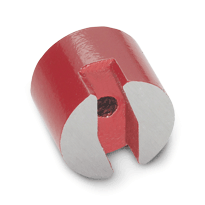
Retaining magnets offer a simple, gentle way to hold objects in place. As their name suggests, they are magnets that are designed to “retain” an object. You don’t have to drill into the object. Assuming the object is magnetic, you can place it over a retaining magnet. Follow these tips to choose the right retaining magnets for your needs.
Rare Earth Construction
You should consider choosing retaining magnets made of a rare-earth element. Most magnets fall under the category or ceramic or rare earth. Ceramic magnets are made of a ceramic material, whereas rare-earth magnets are made of a rare-earth element, such as neodymium or samarium cobalt. When compared to ceramic magnets, those made of a rare-earth element are able to produce a stronger magnetic field.
Flat vs Cylindrical
Some retaining magnets consist of a flat, disc-like shape. Others consist of a longer cylindrical shape. If you’re going to buy retaining magnets, you should choose an appropriate shape.
Disc-shaped retaining magnets are smaller and lighter than cylindrical-shaped retaining magnets. With that said, cylindrical-shaped retaining magnets produce a stronger magnetic field. For small objects, disc-shaped retaining magnets may suffice. If you’re planning to use them for larger, heavier objects, though, you may want to choose cylindrical retaining magnets. They will produce a stronger magnetic field, so they can accommodate heavier objects.
Easy of Installation
You should choose retaining magnets that are easy to install. Most retaining magnets feature either a threaded hole or a threaded stud for installation. If a retaining magnet has a threaded hole, you’ll need a bolt or screw to install it. You can drive the fastener through the magnet’s hole and into the underlying surface, such as a wall.
If a retaining magnet has a threaded stud, you’ll need to install it in the threaded hole of a given surface. You can drill a hole in the surface. You can then twist the retaining magnet’s stud into this threaded hole. As long as a retaining magnet features either a threaded hole or a threaded stud, you should be able to easily install it.
Rubber Coating
Some retaining magnets feature a rubber coating. They still have a rare-earth construction consisting of a neodymium core. But they are coated in rubber.
Rubber-coated retaining magnets will protect the objects with which they are used from damage. The rubber coating is soft. You can place an object against a rubber-coated retaining magnet without fear of it being scratched, scuffed or otherwise damaged. t
